Comments in Response to the FAA Neighborhood Environmental Survey (NES)
The following comments are in response to the Federal Aviation Administration [Docket No. FAA–2021–0037] - On the Neighborhood Environmental Survey (NES) finding that the level of annoyance in response to aviation noise is much higher than previously acknowledged.
Those who want to submit comments on this topic can do so at Regulations.gov through March 15, 2021.
The following submission by Miki and David Barnes is in 4 sections:
- Introduction
- Screenshots Depicting Air Traffic over Washington County, Oregon
- Comments on the Effects of Noise on Reading Comprehension and Learning
- Policy Recommendations
Introduction
Thank you to the FAA for the Neighborhood Environmental Survey (NES) and the public recognition that the number of people highly annoyed by aircraft noise is far greater than previously acknowledged. FAA efforts to shed additional light on these issues in combination with substantive efforts to find solutions are greatly appreciated.
That being said there are some significant shortcomings in the survey, especially insofar as it did not adequately address the incessant noise generated by general aviation pilot training facilities. At the commercial airports surveyed for the NES, the majority of operations are arrivals and departures that fly from one airport to another often crossing one or more state boundaries before arriving at their destination. A major difference between commercial airports and GA flight training facilities is that student and recreational pilots often depart from and return to the same airport after practicing their noisy, toxic maneuvers over homes, neighborhoods, schools, daycare facilities, senior centers, parks, recreational areas, prime farmland, and waterways often for an hour or more.
The U.S. has a glut of airports, approximately 20,000, including 500 commercial facilities and more than 19,000 general aviation airports. By comparison, Europe, with a population over twice that of the U.S., has 2,323. (See General Aviation Manufacturers Databook for 2019, pgs 41-42).
Federal Aviation Administration (FAA) statistics reveal that in 2019 there were 624,065 certified pilots nationwide. This figure, which includes flight instructors and student pilots (many recruited from overseas), represents less than one-quarter of one percent of the entire population. The more than 19,000 GA airports in the U.S. exist primarily to serve this entitled few, a small minority that is responsible for subjecting the rest of the population to hour upon hour of intrusive, unwelcome noise as well as lead emissions, PM2.5, and a host of other toxic pollutants. It is also worth noting that 92 percent of all certified pilots in the U.S. are men. Thus, general aviation is largely a male dominated, white privilege activity.
A case in point is the Port of Portland owned and operated Hillsboro Airport (HIO), the largest general aviation airport in Oregon. According to the FAA Airport IQ5010 Master Records database, HIO logged 253,847 operations in the 12 months ending on 7/13/2020, an average of 695 operations per day. The EPA 2014 National Emissions Inventory ranked HIO 11th out of 20,000 airports nationwide in lead emissions. It is the largest facility source of airborne lead pollution in the entire state.
Screenshots Depicting Air Traffic over Washington County, Oregon
The screenshots in the section below illustrate some of the widespread, negative impacts of aviation on Washington County residents.
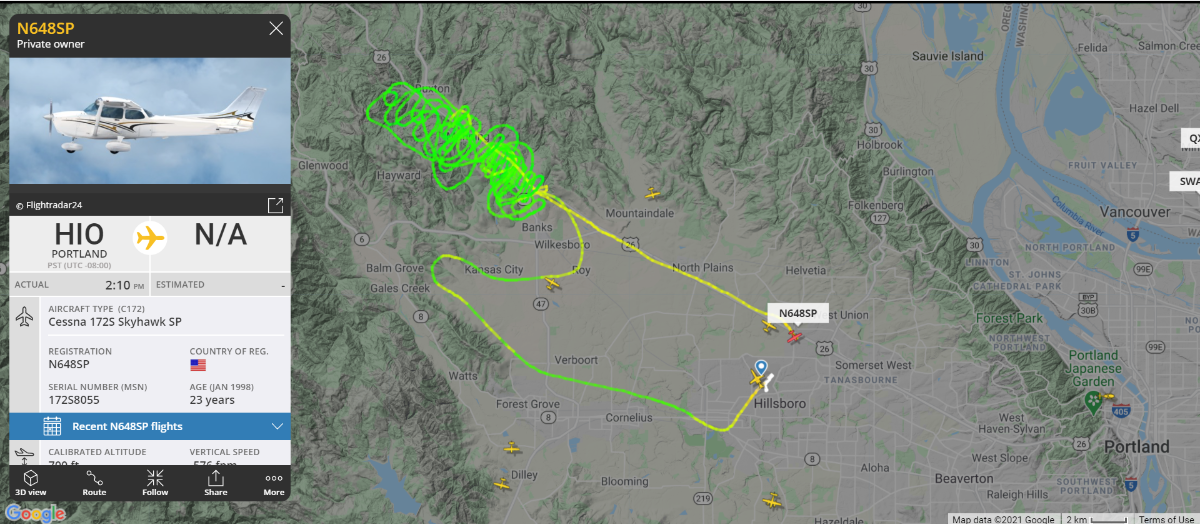
The flight pattern shown in this picture was taken on 03/09/2021 at 3:39 pm. It was generated by a Cessna Skyhawk N648SP, registered to Hillsboro Aero Academy, an international flight training school based at HIO. The pilot circled and looped repeatedly for more than one and half hours. Our home is located 12 miles from HIO, somewhere beneath the tangle of incessant noise, lead emissions, PM2.5, and other toxic pollutants spewed by the extraordinarily rude, inconsiderate and aggressive individual piloting this aircraft. Unfortunately, operations of this nature often occur multiple times daily in the skies over Washington County.
The remaining screenshots, taken on Monday 03/08/2021, help to show the enormous amount of aviation activity over Washington County. With 601,592 people estimated to live within its borders, it is the second most populated jurisdiction in Oregon. One of the primary tenants at HIO is the Hillsboro Aero Academy which boasts of training pilots from over 75 countries. ATP also provides pilot instruction at this airport. In addition to HIO, noise and pollution is generated by aircraft from other nearby general aviation training airports including Stark's Twin Oaks - 6 miles S of HIO, Aurora Airport 19 miles SE of HIO, Scappoose Industrial Airpark 14 N of HIO and McMinnville Airport 22 miles S of HIO. Flights from Portland International (PDX), the largest commercial airport in the state located 15 miles E of HIO, also overfly the area.
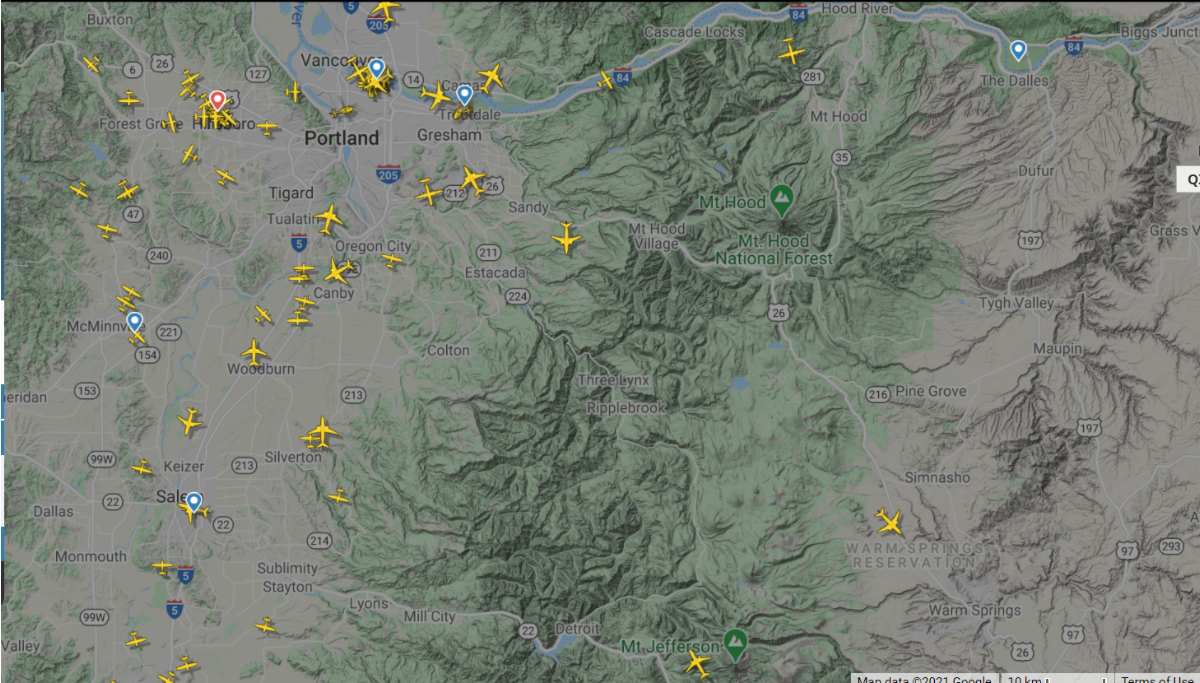
The screenshot above was captured on 03/08/21 at 1:42 pm. The red marker in this image shows the location of the Hillsboro Airport (HIO). The blue markers indicate the locations of some but not all of the other airports in the area. There are more than 50 aircraft visible in this photo. Most are general aviation flights, many of which circle and loop repeatedly for hours on end. March is considered a slow month. The skies become significantly more congested during the summer. Some days, aircraft noise is audible continuously from early morning until late at night, even in woodland and rural communities located more than 10-20 miles from the offending airport.
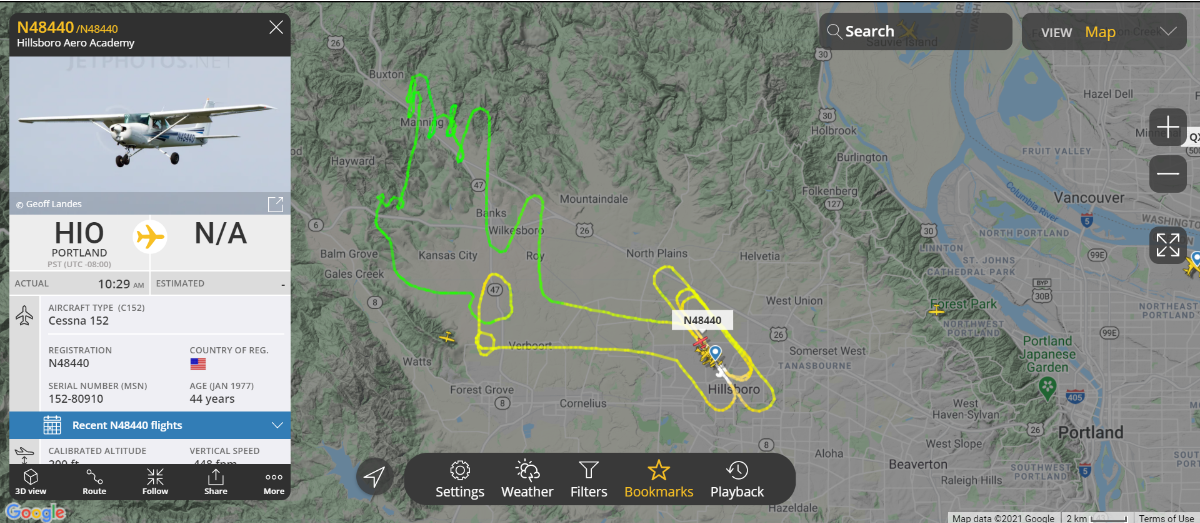
This 3/8/2021 Hillsboro Aero Academy training flight, N48440, had been in the air for over an hour when this screenshot was captured at 11:35 am. Note the touch-and-go patterns close to the airport. After looping multiple times over the Manning/Buxton area, 12 to 15 miles from the airport, the pilot returned to HIO, an airport that is surrounded on three sides by residential neighborhoods and on the fourth by rural homes and prime farmland. Aircraft fly over numerous homes, schools and day care centers while engaged in these noisy, polluting, low-altitude touch-and-go maneuvers.
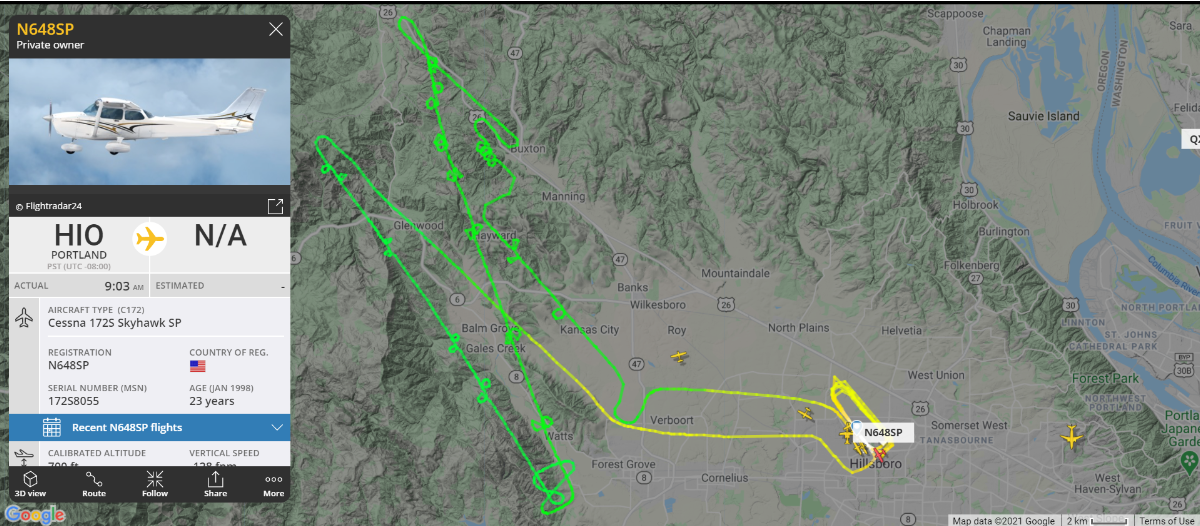
This screenshot of Hillsboro Aero Academy flight N648SP was captured at 10:34 am on 03/08/2021. The aircraft had been looping and flying in tight circles over Western Washington County for 90 minutes when this picture was taken.
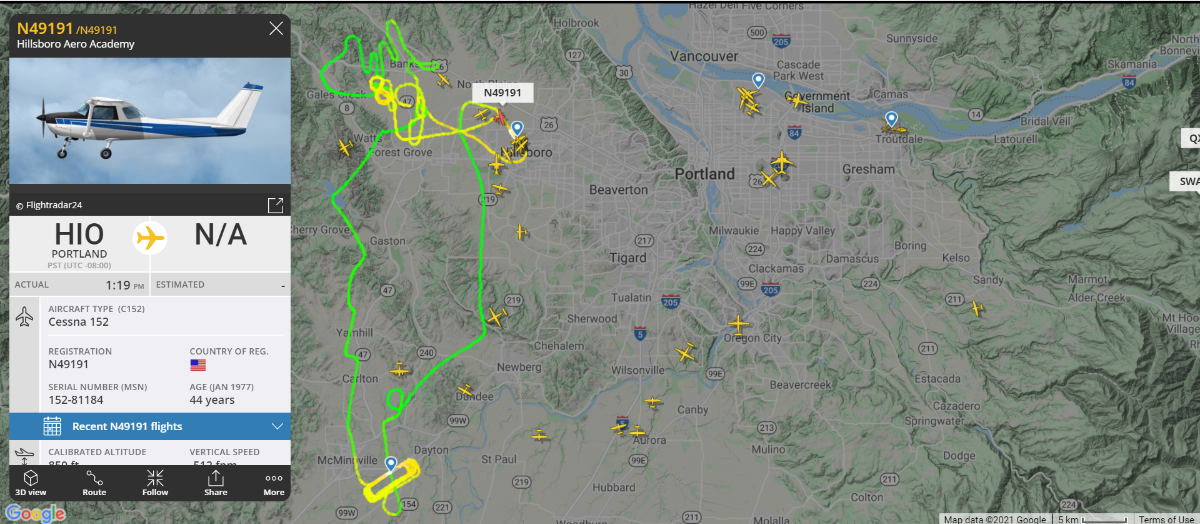
This Hillsboro Aero Academy flight, N49191, departed from the Hillsboro Airport at 1:19 pm then flew south to the McMinnville Airport where it engaged in a series of touch-and-go's before flying north to circle and loop over Banks and surrounding communities.

This 03/08/2021 Hillsboro Aero Academy flight, N648SP, had been in the air for an hour when this screenshot was captured at 3:36 pm.
The above examples represent but a small fraction of the aircraft activity residents of this community are subjected to on any given day. The noise is often relentless. Despite multiple complaints filed with the FAA and the Port of Portland Noise Office as well as local, state and federal officials, nothing has been done.
The Port of Portland Noise Office steadfastly refuses to address this issue. Their claim is that the FAA has determined these operations are legal and acceptable despite the negative impacts on livability, the environment and public health. As a result, local residents, who were denied a democratic voice in the process, are left with no recourse.
It is worth noting that the Port of Portland affixes a flowage fee to every gallon of gas sold at HIO. As such it profits from exploiting and compromising the health and well-being of local residents on behalf of the aviation sector. The Port also accrues financial benefit from leasing facilities to international flight schools and other tenants. This inherent conflict of interest sheds light on why many consider contacting the Port's Noise Office, in hopes of equitable resolution, an act of futility.
Effects of Noise on Reading Comprehension and Learning
According to the FAA–2021–0037 section on studies related to the effects of noise on reading comprehension and learning in children, “The FAA has invested more than $440 million in sound insulation treatments at schools around the country in order to mitigate any potential issues related to aircraft noise.” Unfortunately, insulating schools does not address the problem as children need to engage in play, recreational activities, and sports on school property outside of the actual building structure. In addition, opening classroom windows can contribute to improved air circulation and ventilation, a strategy that can help in managing viruses such as COVID-19.
There are numerous studies documenting the importance of fresh air and spending time outdoors to promote optimal physical and mental health. The presumption that children should be sealed into airtight buildings to protect them from the impacts of aviation noise and pollution is a twisted and convoluted approach to the problem. A more appropriate solution would be to eliminate the noise and pollution by reducing and prohibiting flight training and recreational flying in the vicinity of people's homes and neighborhoods in both urban and rural locations. To reduce unnecessary commercial flights, businesses can be urged to engage in on-line meetings to the greatest extent possible.
Children and other family members learn, read and work in their homes and within communities that are all too frequently plastered with noise and other pollutants, generated not only by Next-Gen commercial flights but also by the massive amount of flight training and other general aviation operations resulting from government policies that essentially foist the cost, noise and pollution burden of international flight training onto the American people.
An obvious first step towards ensuring children learn and thrive in healthy environments is to stop intentionally dousing them in multiple daily doses of noise, lead, PM2.5, and other toxic pollutants. Towards this end policies that significantly reduce air traffic must be established.
Policy Recommendations
The Neighborhood Environmental Survey (NES) represents new evidence that must be incorporated into FAA aircraft noise policies. The NES results show that a much greater proportion of people are highly annoyed by aircraft noise across all levels of DNL than was previously thought. As illustrated in the screenshots, flight training aircraft are responsible for much of the noise in Washington County. Affluent recreational pilots also contribute to the noise footprint.
Previous studies (Schultz curve, FICON study) underestimated aircraft annoyance because they included all transportation noise (e.g. road and rail), and used a mix of older, less robust methodologies. The NES study is specifically about aircraft noise annoyance and uses newer methodologies for its design and modeling.
The NES results should trigger a major change in aviation noise policy because they refute the long-standing Schultz curve and FICON which have been the foundations of existing aviation noise policy. The FAA has an ethical obligation to change regulations that are detrimental to the public, that are under its authority, and that do not require new legislation. The FAA should provide a timely roadmap for changing its noise regulations and use the NES results as the new basis for decision-making on community impacts, including in the FAA's Environmental Review Process and Part 150. The FAA should use additional, existing metrics, notably “N-Above,” which counts the number of aviation noise events over a certain location and decibel level, to better reflect noise impacts on communities.
The lower ambient noise levels of rural and woodland communities should also be factored in regardless of decibel ratings due to the intrusive nature of aviation activity and its interference with the enjoyment of property. In addition, the negative impact of general aviation airports and flight training must be addressed.
Local communities should have a democratic vote in the process. Port commissioners should be elected rather than appointed to insure equitable and just treatment of the greater population. In addition, the FAA should terminate their top-down policy of ignoring environmental and public health concerns on the basis of grant assurances.
New noise metrics do not have to be developed or researched before changing noise policy.
Finally, a re-education campaign aimed at deconstructing the notion that flying and owning aircraft confers status, is in order. In fact, aircraft are major contributors to global warming, pollution, and noise. Piston engine aircraft are responsible for 62 percent of lead emissions in the U.S. There was a time when smoking cigarettes was thought to be cool and desirable. We now know that tobacco is a carcinogenic toxin that poisons both smokers and those who secondarily come into contact with the smoke. Aircraft noise and pollution pose a similar threat. Strict penalties need to be put into place to protect the greater good from the noise and toxicity of the aviation industry.
Thank you for your time and consideration.
Miki and David Barnes
Washington County, Oregon
| © Oregon Aviation Watch | Contact Us |  Jump to Top Jump to Top |
